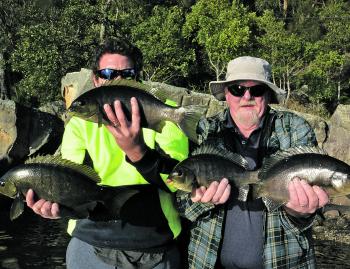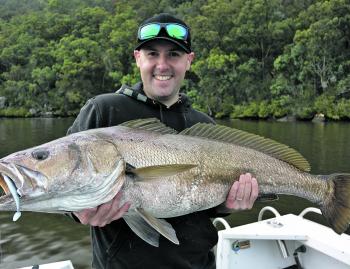The first month of winter marks the start of some superb fishing on the Hawkesbury and its tributaries. Anglers willing to brave the cool conditions can expect to encounter luderick, bream, flathead, estuary perch, Australian salmon, tailor and mulloway.
Luderick will be schooling on the lower rock walls around Broken Bay and can turn on some exciting sessions on a high tide and during the run-out. Anchoring your vessel side-on to the current with a bow and stern anchor is preferred, but not essential. The most important thing is the location you have picked.
You need to look for areas that have back eddies and current lines around major junctions and points. Big boulders that stick out into the main current flow are prime habitats for luderick and are always worth a drift or two with your perfectly weighted float rig. Sourcing fresh weed is a key factor and most experienced luderick fishers keep their best weed collecting areas top secret.
Some areas I have found to hold good cabbage and stringy weed are on the bases of old boat hulls (mooring minders) and on pontoons and jetty poles that have good clean water flowing past them. Berley is great, but not as necessary as finding a good concentration of fish schooling up.
Bream have been schooling in the lower reaches and holding in tight and down deep on the rock walls from Bar Point back downstream to Broken Bay. I find working soft plastics and blades parallel to the deeper walls to be quite effective when they are schooling between 5-10m deep. Small soft plastic grubs and minnows in natural colours to suit the water colour will prove to be the best producers. Bloodworm, pumpkin seed and motor oil are my firm favourites. Bream will eat most things you throw at them though, as long as you fish it slowly and in their faces down deep.
Bait fishing the washes will prove fruitful for both the above mentioned species, and the odd drummer too. A bucket of mashed up bread berley and baits of peeled prawn or fresh bread kneaded onto your small no. 1 bait keeper hook produces some great sessions at this time of year.
Flathead will be in decent numbers around Broken Bay and Cowan, and further upstream to Berowra to a lesser degree. Soft plastics, soft vibes and blades are the most effective for covering water to find where the active concentrations of flatties are on any given day. Drifting over the cockle beds and around major points with lightly weighted baits of prawn or white bait will also account for some nice fish, if lure casting is not up your ally.
Salmon and tailor can be found by casting soft plastic minnows and surface poppers or trolling skirts and diving minnows along the washes around Barrenjoey, West Head and Lion Island. You can also catch these fish out in the open in Pittwater near Palm Beach and across to the basin and Broken Bay around Little Pittwater and Hungry Beach.
Keep your eyes open for diving gulls and terns, and approach slowly to gauge the direction of the school. Moving your vessel to intercept the school in the direction they are feeding will give you a much better chance of getting a hook-up on these often fussy feeders. Small metal slices, soft plastic minnows and flies are best to cast to these fish.
Estuary perch will start to feature in captures as they head downstream in large numbers to spawn in the more saline waters in the lower reaches. They are usually a by-catch when you’re targeting flathead, bream or mulloway. At times they’ll take lures up to 5” long. As they are in a closed season they should be returned to the water with a minimum of fuss and handling. Ideally they shouldn’t be removed from the water, if possible.
Mulloway have been biting very well since the fresh earlier in autumn. Lots of 1m+ fish have graced the deck of my vessel, and plenty of other anglers’ boats too. Big fish will be haunting the headlands and lower estuary this month, especially if the luderick and mullet are in good numbers in the same areas.
Gathering live baits will be best done around West Head and at times out the front at Barrenjoey, Lion Island and Little Box Head. Tailor, pike, squid and yakkas will all be taken readily by a big mulloway at this time of year. I prefer to cast and retrieve lures though. Lure fishing allows you to cover large amounts of water with a range of offerings in varying colours and sizes.
If you want a truly large mulloway on a lure you must throw large lures of 6-9” that will tempt only the biggest of fish. The downside to this is that it will wear you out after a couple of hours of casting. I prefer to use smaller lures of 3-6”, as they are more manageable for longer periods of time on a lighter outfit, and usually produce a few by-catches of estuary perch, flathead and bream along the way.
Reads: 9469
The Hawkesbury can produce some amazing sessions on big 40cm+ luderick.

Some impressive mulloway were captured on lures and baits after the fresh back in early autumn.

Big bream will be keen to snaffle lures and baits around Broken Bay as the water temperatures keep dropping.

Lindsay caught this 118cm mulloway on a Pro Lure 105 Fishtail on a recent charter with the author. Lure fishing for mulloway this winter is set to be awesome!




